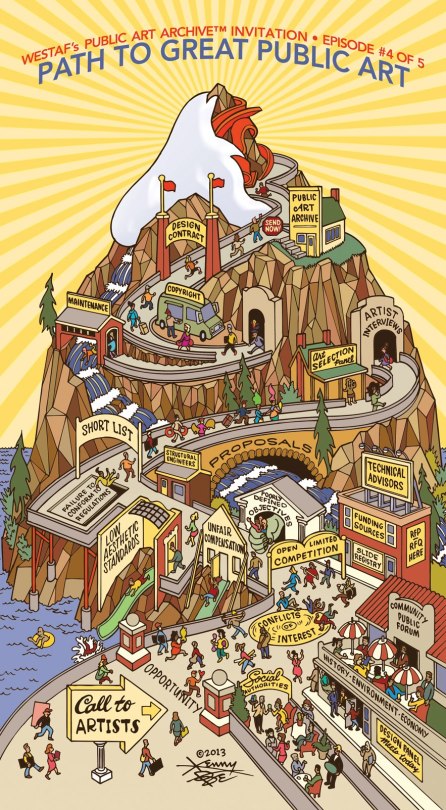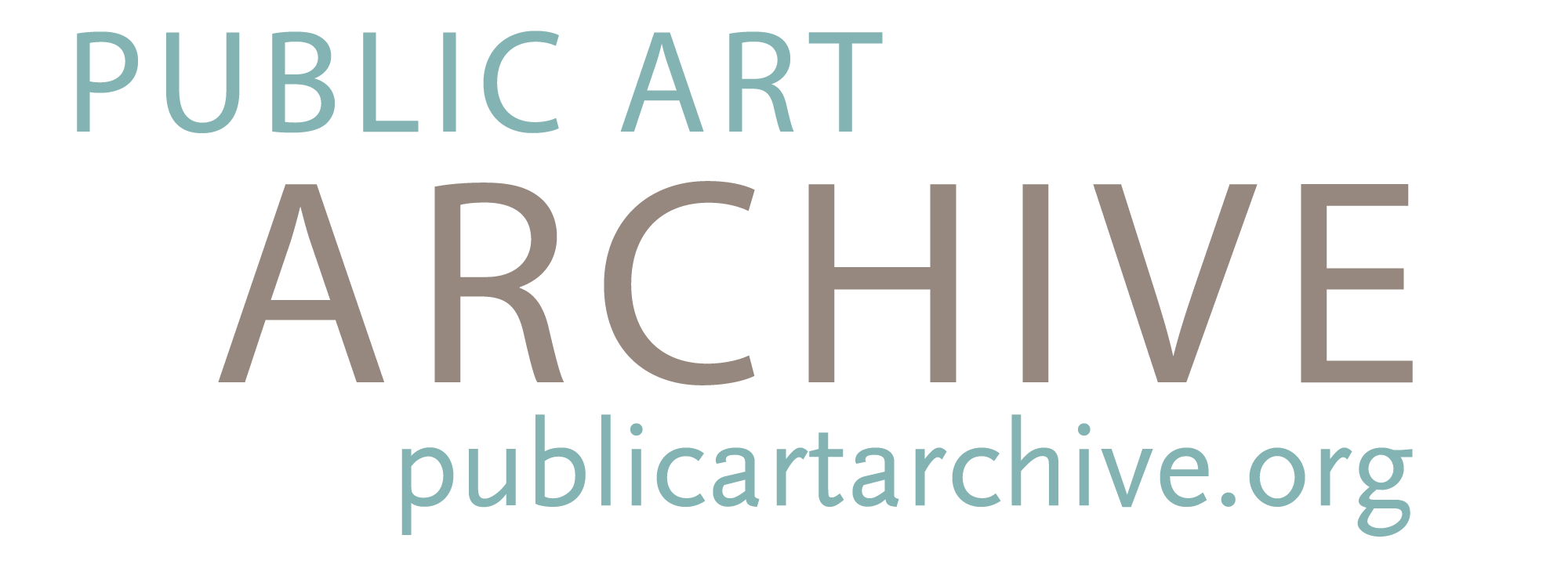Written By: Elysian Koglmeier on behalf of the Public Art Archive

© Kenny Be, 2013
“I have not failed. I’ve just found 10,000 ways that won’t work.” – Thomas A. Edison
“Learn from the mistakes of others. You can’t live long enough to make them all yourself.” – Eleanor Roosevelt
Commissioning public art is a long and arduous road met with unforeseen roadblocks and potholes that keep us from a smooth ride. As public art administrators, we’ve become accustomed to this and know to focus on the road ahead and drive onward to our worthwhile destination – a meaningful public art work installed in our community.
This blog shares key learnings from public art administrators across the country. It serves as a roadmap with the roadblocks marked – like the Waze app alerting us of a vehicle stopped on the road ahead. “As collaborators in the public art field, it is imperative that we share experiences with our growing network in order to advance the professionalism of the field. All of us have had successes and failures, and all of us can learn from each other if we emphasize the importance of field-wide feedback and evaluation of our experiences,” says Lori Goldstein, Program Manager for the Public Art Archive.
From evaluation to maintenance to constituent education, you’ll hear from 5 public art administrators about challenges they’ve faced in their programs.
Read along and remember…
“A life spent making mistakes is not only more honorable, but more useful than a life spent doing nothing.” – George Bernard Shaw
Don’t underestimate the maintenance plan.
Anne Delaney, Executive Director, Initiative for Public Art – Reston
Reston, Virginia
One of the mistakes to avoid when commissioning public artworks is underestimating the importance of planning for the maintenance of the artwork, whether permanent or temporary, and gathering all the information necessary to maintain the artwork properly.
Very often addressing maintenance issues is not considered as much of a priority. I highly recommend the adoption of a maintenance plan that can be completed by the artist and shared with the entity commissioning the public artwork. This will ensure that the latter will be aware of the resources required (staff time, conservator costs, and budget) to ensure that the public artwork will be taken care of appropriately and can be enjoyed by all for as long as is reasonably possible.
One should also consider establishing a budget for the maintenance of public artworks.
Find out more about Reston’s Public Art collection on the Public Art Archive.
Avoid using public art as an aesthetic bandaid on bad architecture.
Jack Becker, Founder and Director of Community Services Program, Forecast Public Art
St. Paul, Minnesota
Too often architects finish their plans for a building without thinking of integrating public art as an integral feature. They put an X on the blueprints where the art should go—typically on a blank wall or expanse of pavement. The discussion about siting public art in a new building should start early on in the planning and design process, so the art is not an afterthought. If an artist can be selected early on to collaborate with the architect on the integration of art, the results will typically be more impactful, save money, and feel like it was intended from the outset.
Read more about Forecast Public Art’s Public Art and Placemaking Tool for City Planners.
Forecast is collaborating with WESTAF on this year’s Symposium – The Future History of Public Art. We have a few observer seats left – contact the Public Art Archive today to register.
Do not assume everyone knows. What is common knowledge to you, is not common knowledge to everyone.
Rebecca Rothman, Director of Public Art, City of Tempe
Tempe, Arizona
A few years ago I managed a project that required federal security clearance for all artists, designers, and project managers involved. After a lengthy process that included federal background checks and homeland security clearance, one artist posted a video on his personal social media that was tense (to say the least). He meant no harm and thought the video was innocent and fun; however, the content of the video was highly controversial.
Where he saw humor, I saw a nightmare that consisted of meetings with elected officials, memos to the City Manager, and, ultimately, the death of our promising public art project.
The artist had shared this post with me, thinking it was funny, and my response was an immediate phone call where I nervously explained why this was a problem and how this could be viewed by our management team (and others). Thankfully, he understood, apologized and removed the video, leaving no remnant for further discussion.
The project went on to be a success for all parties but it taught me a huge lesson – I should have taken the time to explain why there was a need for the security clearance in the first place.
Moving forward, I assume that what is obvious to those of us working in government is not common knowledge to others, including those we collaborate with – artists, community members, consultants, and designers.
Find out more about Tempe’s Public Art collection on Public Art Archive.
Don’t overcomplicate your evaluation methods.
Sherri Brueggeman, Public Art Urban Enhancement Program Manager
Albuquerque, New Mexico
Don’t try to over prescribe or define expectations prior to the commissioning process as a means to achieve successful evaluation data.
The Albuquerque Public Art Program, inspired by the IXIA Guide to Evaluation, developed a massive evaluation matrix with eight overarching criteria and 50 sub-criteria. Each overarching criteria was assigned a numerical percentage while the sub-criteria were to be ranked High, Medium or Low.
The matrix, which had to be printed out on 11”x17” paper to be legible, became a complete hindrance to the discussion and consensus process of defining the project goals and artwork selection tasks done by the art selection committees. Not only did the small poster-sized form terrify the art selection committee, it also became a process to convert the criteria into comprehendible and useful information for the artists reading and applying to the call.
We’ve since ditched the massive form and don’t haul it out at meetings and let anyone see it. But, we do still use the categories on the form internally to help us remember to ask the committee participants to consider these criteria.
Find out more about Albuquerque’s Public Art collection on Public Art Archive.
Consider interactivity, whether welcomed or not, and consequential maintenance.
Frank Wick, Collection Manager, Austin Art in Public Places
Austin, Texas
At Austin AIPP we work with artists from the moment they are commissioned to ensure maintenance limitations are understood and considered during design. As a collection manager, evaluating an artist’s concepts with an eye toward future maintenance is my natural inclination.
That said, we still have surprises.
A recent issue came up with a series of sculptures set in a city sidewalk near hotels and restaurants, which were purposely positioned to discourage skateboarders and bicyclists from grinding on them.
The skaters and bicyclists didn’t get that memo however, because the sculptures were immediately used as sport objects (including by someone who may have been wielding a baseball bat) to the point we now have 8 of the 25 sculptures requiring repair.
The sculptures are now wrapped, with signs stating “Ouch! Please don’t hurt us!” with a picture of an adhesive bandage, and “Don’t monkey around” with a monkey pictured.
Thankfully the damage has slowed way down. We are working with the artist and our Public Works Department to come up with a permanent solution before we make the needed repairs, which may include softening of the surface around the sculptures to eliminate the “runway” to the sculptures.
Check out AIPP’s Public Art Archive’s Collection Showcase!
What is a Public Art Archive Collection Showcase? An incredible opportunity to simplify your workflow and showcase your public art collection.
- Generate a website instantly.
- Reinforce your brand.
- Customize multimedia content as often as you’d like.
- Integrate social media channels to drive traffic to your site.
- And encourage and publicize exploration of your collection.
